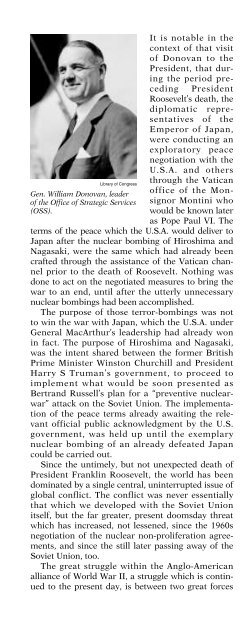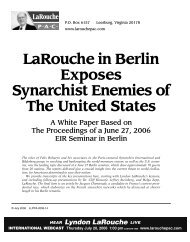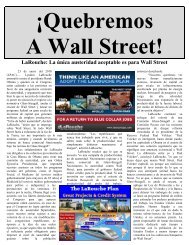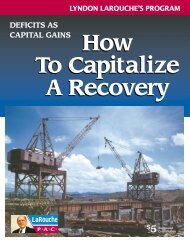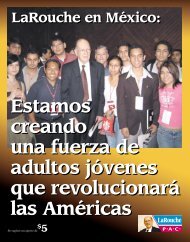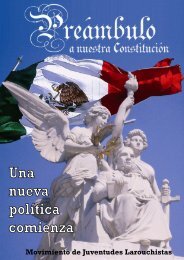Franklin Roosevelt's Legacy Franklin Roosevelt's Legacy
Franklin Roosevelt's Legacy Franklin Roosevelt's Legacy
Franklin Roosevelt's Legacy Franklin Roosevelt's Legacy
Create successful ePaper yourself
Turn your PDF publications into a flip-book with our unique Google optimized e-Paper software.
Library of Congress<br />
Gen. William Donovan, leader<br />
of the Office of Strategic Services<br />
(OSS).<br />
It is notable in the<br />
context of that visit<br />
of Donovan to the<br />
President, that during<br />
the period preceding<br />
President<br />
Roosevelt’s death, the<br />
diplomatic representatives<br />
of the<br />
Emperor of Japan,<br />
were conducting an<br />
exploratory peace<br />
negotiation with the<br />
U.S.A. and others<br />
through the Vatican<br />
office of the Monsignor<br />
Montini who<br />
would be known later<br />
as Pope Paul VI. The<br />
terms of the peace which the U.S.A. would deliver to<br />
Japan after the nuclear bombing of Hiroshima and<br />
Nagasaki, were the same which had already been<br />
crafted through the assistance of the Vatican channel<br />
prior to the death of Roosevelt. Nothing was<br />
done to act on the negotiated measures to bring the<br />
war to an end, until after the utterly unnecessary<br />
nuclear bombings had been accomplished.<br />
The purpose of those terror-bombings was not<br />
to win the war with Japan, which the U.S.A. under<br />
General MacArthur’s leadership had already won<br />
in fact. The purpose of Hiroshima and Nagasaki,<br />
was the intent shared between the former British<br />
Prime Minister Winston Churchill and President<br />
Harry S Truman’s government, to proceed to<br />
implement what would be soon presented as<br />
Bertrand Russell’s plan for a “preventive nuclearwar”<br />
attack on the Soviet Union. The implementation<br />
of the peace terms already awaiting the relevant<br />
official public acknowledgment by the U.S.<br />
government, was held up until the exemplary<br />
nuclear bombing of an already defeated Japan<br />
could be carried out.<br />
Since the untimely, but not unexpected death of<br />
President <strong>Franklin</strong> Roosevelt, the world has been<br />
dominated by a single central, uninterrupted issue of<br />
global conflict. The conflict was never essentially<br />
that which we developed with the Soviet Union<br />
itself, but the far greater, present doomsday threat<br />
which has increased, not lessened, since the 1960s<br />
negotiation of the nuclear non-proliferation agreements,<br />
and since the still later passing away of the<br />
Soviet Union, too.<br />
The great struggle within the Anglo-American<br />
alliance of World War II, a struggle which is continued<br />
to the present day, is between two great forces<br />
which were committed, from the beginning of that<br />
time, to an underlying conflict which has continued<br />
as the central global strategic issue of the present<br />
moment. This was never essentially between the<br />
U.S.A. and the Soviet Union; rather, the conflict with<br />
the Soviet Union was a by-product of the primary<br />
danger to civilization, then, a danger which is more<br />
than ever that still today.<br />
This underlying conflict was, and is, as today’s<br />
mounting world crisis shows, essentially, a conflict<br />
between those two great forces best identified, on<br />
the one side, as the tradition of the modern sovereign<br />
nation-state, as best typified by the founding<br />
and development of the U.S. Federal Republic, and,<br />
on the opposing side, a powerful, global syndicate of<br />
private financier forces which presently control<br />
much of the world through their control over those<br />
so-called central banking systems, which have constituted<br />
themselves as a self-declared imperial<br />
power, which reigns from above the level of virtually<br />
all national governments.<br />
No other global issue can be competently defined<br />
and understood, unless this issue is first recognized<br />
as the most essential strategic challenge to human<br />
existence in our nation, and throughout this planet,<br />
at the present time.<br />
A. Our Synarchist Enemy Today<br />
That great enemy of civilization at the time of the<br />
celebrated, post-World War I Versailles Conference,<br />
had been a powerful interest composed of a club of<br />
private financier interests which had grouped itself<br />
into what was then known as the Synarchist<br />
International. This was the group of private<br />
financier interests associated, during the following<br />
decade and beyond, with both a trans-Atlantic network<br />
centered on the Bank of England’s and Brown<br />
Brothers’ Montagu Norman, and with a Paris-centered<br />
Synarchist cabal, a group which would soon<br />
create the fascist movements of the 1922-1945 interval,<br />
but which would come, later, almost unscathed,<br />
having escaped from the formality of post-war “de-<br />
Nazification” efforts, to menace civilization more<br />
than ever before, as today.<br />
That conflict today is between the continued existence<br />
of the institution of the sovereign nation-state<br />
republic and the threatened early establishment of a<br />
bankers’ world tyranny, under which latter force the<br />
power of a perverted, Lockean notion of “property<br />
right,” a notion represented by syndicates of private<br />
financier cabals, would rule and ruin those nominal<br />
national governments which the bankers would permit,<br />
by exception, to continue to exist.<br />
The accursed Genghis-Khan-like raids, around<br />
the world, by the predatory hedge-fund hordes, and<br />
7


